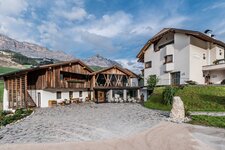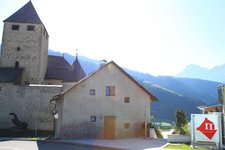The formerly rather isolated valley has become one of the most popular holiday destination of the Alps
The valleys surrounding the Sella alpenstock are inhabited by Ladin-speaking people. One of these valleys is called Val Badia. Alta Badia is situated in the southern part of the valley and stretches on a length of 16 km including the six villages Corvara, San Cassiano, Badia with Pedraces, La Villa, Colfosco and La Val. Despite of the developments in tourism sector, Ladin population has always kept striving for the preservation of language, customs and traditions.
Archaeological findings at "Sotciastèl" in Pedraces confirm that the Val Badia valley has already been inhabited in Bronze Age between the 16th and 13th century BC by Proto-Indo-European tribes or Celts. Further in time, Romans used the collective term "Rhaetians" to describe those people. Under Roman rule, the area surrounding the Sella Group was reorganised in political and administrative terms. This is also when Ladin developed out of the Latin and Rhaetian language.
The year 1027 AD, however, was very important for the valley, which still was quite isolated. When the Princedom of Bressanone was founded, the area on the left riverbank of the Rio Gadera was awarded to the bishop. The area on the right riverbank was assigned to the Pusteria Earldom. In this time also the Italian name "Badia" developed, which derives from "Ciastelbadia", an old Benedictine monastery located in San Lorenzo di Sebato in the nearby Val Pusteria valley.
Between 1803 and the beginning of WWI in 1914, the valley first was transferred to Austria and further on to Bavaria. The war had devastating consequences on the valley and its inhabitants, as many bloody battles took place in the Dolomites during the Mountain Warfare (1915 - 1918). In the end, in 1919 the valley was annexed to the Trentino and thus to Italy.
Franz Kostner, a famous alpine guide of the Val Badia valley reckoned that this area could be a great place for skiing and supported transport development in the valley, as so far it could only be reached on foot or carriage. In 1930, he established a kind of "sleigh lift" from Corvara on Mt. Col Alto. Only four years later he founded the first ski school. Nowadays Alta Badia is one of the most popular skiing areas in South Tyrol.















